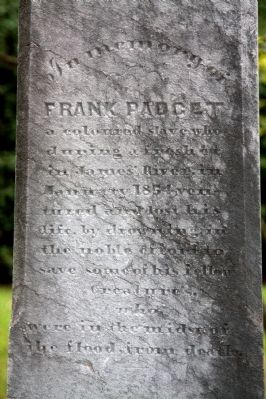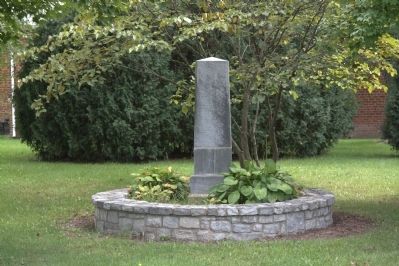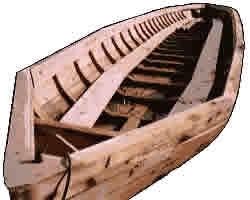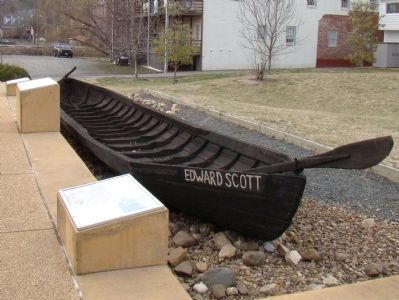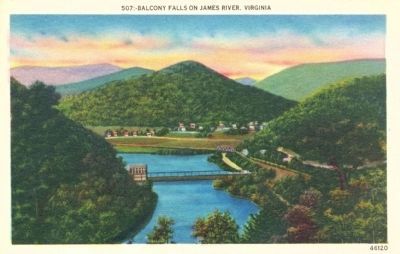Glasgow in Rockbridge County, Virginia — The American South (Mid-Atlantic)
Frank Padget
Erected 1854 by Captain Edward Echols.
Topics. This historical marker is listed in these topic lists: African Americans • Waterways & Vessels. A significant historical month for this entry is January 1854.
Location. 37° 38.035′ N, 79° 27.01′ W. Marker is in Glasgow, Virginia, in Rockbridge County. Marker is at the intersection of Blue Ridge Road (County Route 684) and McCulloch Street, on the right when traveling north on Blue Ridge Road. It is in Centennial Park. Touch for map. Marker is in this post office area: Glasgow VA 24555, United States of America. Touch for directions.
Other nearby markers. At least 8 other markers are within 6 miles of this marker, measured as the crow flies. Frank Padget Water Tragedy (within shouting distance of this marker); Indian and Settler Conflict (approx. 0.6 miles away); Amherst County / Rockbridge County (approx. 2.1 miles away); The Courage Of Frank Padget (approx. 2.1 miles away); Falling Spring Presbyterian Church (approx. 4.3 miles away); Natural Bridge (approx. 5.1 miles away); A Miracle in Stone ... Old as the Dawn (approx. 5.1 miles away); a different marker also named Natural Bridge (approx. 5.1 miles away). Touch for a list and map of all markers in Glasgow.
Regarding Frank Padget. The present-day Maury River was known as the North River until the 1960s. The Blue Ridge portion of the James River and Kanawha Canal ran in the slack water sections of the James River itself. Man-made canals and locks transported canal boats around rapids and falls. Lock 16 was here at Glasgow, where the Maury River flows into the James. The tragedy of the canal boat Clinton occurred while it was in the open waters of the James at the mouth of the Maury. Frank Padget’s rescue attempt occurred a ways down stream, past Balcony Falls.
Also see . . . Frank Padget: A Superhero of the Bateau & Packet Boat Era. Scroll down for the story in this the August 2006 issue of the Amherst County Museum newsletter “The Muse.” (Submitted on November 26, 2011.)
Additional commentary.
1. Excerpt from A History of Rockbridge County, Virginia
1920 book by Oren F. Morton published in Staunton by The McClure Co., Inc. The excerpt reproduced below begins on page 251.
Captain Edward Echols, who lived at the mouth of North River, was a brother to General John Echols, of the Confederate army, and consequently an uncle to the late Edward Echols, of Staunton. He was a citizen of considerable local prominence, and died in 1874 at the age of fifty-seven. An incident in his career illustrates his unselfishness and his generous impulse. It also brought suddenly to the front an unexpected power of vivid narration. The account of the incident which has been furnished to us we quote entire.
(begin
quote)
In January, 1854, a large covered freight boat with a cargo of nearly 100 negro men who had been hired in the vicinity of Richmond to work in the furnaces above Buchanan was swept over the dam on James River at Balcony Falls, in consequence of the breaking of the tow-line, as the boat was struggling across the mouth of North River then swollen by a heavy freshet. Most of the negroes as soon as the boat began to drift down the stream plunged into the river and swam to the bank. About a dozen of them who probably could not swim stuck to the boat and were dashed over the dam into the boiling and foaming whirlpool below. The boat was broken into fragments, and half the men drowned. The others clung to a fragment of the wreck and were drifted down the surging and roaring torrent about a mile and a half, until they struck a large rock called the “Velvet Rock,” from the carpet of soft green moss which covered it, when they jumped off and after much scrambling secured a precarious foothold on the narrow surface of the wet and slippery stone. One of these men was William G. Mathews, uncle to William G. Mathews of the Virgina Western Power Company. The river was rising, the spray dashed over the rock. The weather was freezing, a dark night was closing in, and it was impossible to send a boat through that surging torrent to bring off the shipwrecked sufferers, whose doom seemed to be sealed. To encourage them to hold on to their perilous position and to cheer their desponding spirits, a large fire was kindled on the opposite bank of the canal, about 100 yards
off, by a body of rough, but kind-hearted men, who sang and danced and shouted around it all that dark and gloomy night. Above the loud roar of the turbid waters as they rushed through the narrow gorge of the Blue Ridge, their trumpet voice could be heard ringing on the midnight air, “Hold on, hold on; dance and sing; we’ll save you; we’ll save you; day is almost here; hold on; hold on; the river is falling; you’re safe; you’re safe.” Thus animated and encouraged, the imprisoned men did hold on through that awful night until the first faint streak of day, when the river having fallen during the night, a canoe danced over the foaming tide and brought the half-frozen men to the bank. And there was such a scene, such hugging, and dancing and laughing, and crying and shouting and rejoicing. A few days later Captain Edward Echols, who resided in the immediate vicinity and was an eye-witness of most of these thrilling scenes wrote a most vivid and graphic account of them, which was published in the Lexington Gazette and copied by many papers in and out of the state. Captain Echols almost literally photographed the whole catastrophe, from the breaking of the rope to the rescue of the men in a series of living pictures taken fresh from nature. You almost saw the boat as it plunged over the dam, and heard the shrieks of the drowning and drifting men. The style was perfectly simple and unpretending— like naive Isaac Walton in his “Compleat Angler”—a style which every school boy thinks he can write until he tries, but which the critics say has never
been successfully imitated,—fresh, racy, nervous, pictorial, and yet familiar, colloquial, easy and natural. Captain Echols’s success in that happy effort is easily explained. He felt warmly, the scenes were distinctly pictured on his heart, and his pen naturally copied them. Feeling is the source of eloquence, and simplicity is the source of refinement. It is but simple justice to a man to say that Captain Echols was untiring in his efforts to save these unfortunate men and that they probably owe him their lives. The same praise is due to another worthy man, Peter A. Salling. A negro named Frank Padgett, who belonged to a gentleman of that name in Amherst, was drowned in a voluntary and heroic effort to save some of these imperilled men. The humane and martyr-like conduct of this poor slave, who simply yielded to his natural sympathies for his suffering fellows made a deep impression on Captain Echols’s susceptible heart, and most justly encited his warm admiration. To commemorate this noble deed he erected at his own cost an enduring monument to Frank’s memory at the lock opposite the “Velvet Rock” about a mile and a half below the dam, in the midst of the wildest and grandest scenery in Virginia, where the gurgling and foaming river dashes in tiny cascades through the overhanging mountains, and sweeps off in a glittering stream of silver. The traveler may observe a stout obelisk of dark marble bearing the following inscription:
“IN MEMORY OF FRANK PADGET a colored slave who during a freshet in James River in January, 1854, ven- tured and
lost his life by drowning in a noble effort to save some of his fellow creatures who were in the midst of the flood from death.”
If the hearty admiration and commendation of noble and generous action is the next thing to performing them, then when Captain Echols so generously erected this monument to this poor, humble negro, who deserved it far better than many an overpraised and vulgar hero who dies on the field of battle, he illustrated the nobleness of his own heart and built for himself, let us hope, an enduring monument in the hearts of his countrymen.
(end quote)
When the canal was sold to the Richmond and Alleghany Railroad Company, it was stipulated that the monument should not be disturbed, and a railing was placed around it.
— Submitted November 26, 2011.
Credits. This page was last revised on February 3, 2020. It was originally submitted on November 26, 2011, by J. J. Prats of Powell, Ohio. This page has been viewed 1,385 times since then and 35 times this year. Photos: 1, 2, 3, 4. submitted on November 26, 2011, by J. J. Prats of Powell, Ohio. 5. submitted on November 30, 2011, by J. J. Prats of Powell, Ohio.
